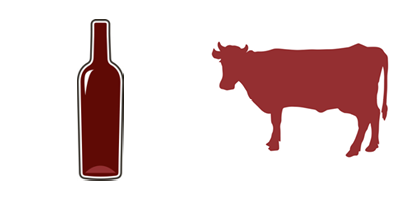Riesling
Where from: Originally from the German Rhine region, it is also a staple of Alsace, in France, right across the border. Many other countries like Canada grow it, too. Especially in Australia, Riesling is considered to be a long-living wine.
In the glass: Highly aromatic, with flowery, almost perfume-y, notes and strong acidity.
Impress the wine snobs: Riesling is a grape that expresses terroir, meaning it tastes very different in Germany (apple notes, high acidity) and in nearby Alsace (sweeter, citrus, peach notes).
Gewürztraminer
Where from: Traminer is from South Tyrol, an Alpine region in Northern Italy. At some point, traminer traveled to Alsace (them again), where it mutated into the more aromatic gewurztraminer.
In the glass: Heady lychee and rose aromas. It packs a ton of sugar, and makes for off-dry wines that stand up well to spicy food.
Impress the wine snobs: Gewürztraminer looks red or pink but is considered a white grape.
Pinot Gris/Pinot Grigio
Where from: Pinot Gris is the French name. It’s usually from Alsace. Pinot Grigio is the Italian name—it’s mostly grown in Lombardy and Friuli-Venezia Giulia.
In the glass: The Alsatian style has high alcohol, low acidity and an almost oily texture, plus tropical fruit flavors like mango.The Pinot grigio style maintains more acidity and keeps some of the tropical fruit notes in check.
Impress the wine snobs: Pinot gris was first introduced into Australia in 1832.
Sauvignon Blanc
Where from: One of the most famous white grape varieties from the Bordeaux region.
In your glass: Crisp and refreshing. Though it generally produces wines on the drier side, this grape is also blended with others to produce dessert wines, such as those from Sauternes.
Impress the wine snobs: New Zealand’s fresh and vibrant style of Sauvignon Blanc has become extremeley poplar due to it’s strong nose of exotic fruits.
Pinot Noir
Where from: It’s most famous for being used in France’s Burgundy region wines but has now traveled around the world. In Australia, Tasmania, Yarra Valley and Adelaide Hills produce great pinot noir.
In the glass: Medium bodied, with low tannins and red fruit (strawberry, cherry, raspberry) notes. Pinot Noir produces some of the world’s finest wines.
Impress the wine snobs: It is the main varietal used in Champagne, a sparkling white wine.
Chardonnay
Where from: While it originated in Burgundy, it’s grown everywhere these days as it is a fairly neutral grape.
In the glass: While famous for its oaky, buttery flavors, Chardonnay grown in moderate climates can also be lighter and slightly fruity, with notes of peach or apricot.
Impress the wine snobs: Winemakers often toy around with Chardonnay to give it more flavor, by aging it in oak barrels or triggering a malolactic fermention to give it buttery notes.
Cabernet Sauvignon
Where from: A key component in most Bordeaux wines, it’s now grown in every major wine-producing region, from Lebanon to Chile. Only Merlot is more widely planted.
In the glass: Deep rich and spicy wines with high tannins, acidity, hints of herbs, blackcurrant or jam (depending on the climate in which it is grown).
Impress the wine snobs: Two California wines topped the Paris Wine Tasting of 1976, beating Bordeaux, and paving the way for New World wines to finally be taken seriously.
Syrah
Where from: It originated in the Rhone Valley in France but became so popular in Australia as to get its own name there, Shiraz
In the glass: This red grape produces dry wines with a full body and high tannins. Look for flavors of chocolate and black pepper. The Australian Shiraz is riper and richer., with hints of licorice and leather.
Impress the wine snobs: It’s Australia’s most popular red grape.
Muscat Blanc à Petits Grains
Where from: The Muscat Blanc à Petits Grains grape dates back to ancient Greece, making it one of the world’s oldest varietals.
In the glass: It’s used to make sweet fortified wines, like Vermouth in Italy and vin doux naturels in France’s South. You’ll also find it in Italy’s Moscato d’Asti, a sweet sparkling wine.
Impress the wine snobs: Vin doux naturels are wines where you add grape spirit to your wine before the fermentation transforms all the sugar into alcohol. Sweet!
Champagne
Where from: First of all, we’re cheating here. Champagne isn’t a grape varietal. It’s a region in France that makes sparkling wine.
In the glass: A blend of Pinot Noir, Pinot Meunier and Chardonnay, Champagne is naturally bubbly but not naturally sweet. Sugar is added during the second fermentation, leading to Champagnes ranging from extra brut (very dry) to doux (very sweet.)
Impress the wine snobs: There are some amazing sparkling wines from outside of Champagne, too.
Hot Restaurants Serving Bold New Wines
Wine I Love You
Wine I Love You has expanded its empire to the trendy mall Groove at CentralWorld. Amid a handsome bistro vibe, it serves up a range of Comfort food to accompany the floor-to-ceiling list of wines from all around the world. New bottles keep coming in, for those wishing to explore fresh flavors, like the recent arrival, Jacob’s Creek Cabernet Sauvignon Coonnawarra. The bottle presents a strong taste of plum and tobacco leaf with a fresh fruity aroma from blackcurrant and spicy cinnamon. Have it with lamb, beef or cheeses platters.
G/F, Groove at CentralWorld, Ratchadamri Rd. 081-921-2016. Open daily 11am-midnight. BTS Siam/Chit Lom.

Set in a 100-year-old house painted in pink, the restaurant does twists on Asian comfort food, like pad Thai with duck foie gras or salmon tartare wonton tacos. To go with spicy flavors, the restaurant now serves Jacob’s Creek Lamoon, which supports Thai dishes with its fruity flavor (a good complement to chili) and its silky tannins to balance out the meal. Plus, the wine can be served chilled.
401 Silom Soi 7. 02-636-6622. Open daily 5pm-2am. Last Order Midnight. BTS Chong Nonsi

The JW Marriott Hotel Bangkok’s elegant Japanese restaurant is one of the best designed locales in Bangkok for Nippon food. The food consists of contemporary tweaks on authentic Japanese favorites. To go perfectly with the fresh dishes, the restaurant also serves the new Jacob’s Creek Wah, a wine created especially to be paired with Sushi and Sashimi. The white Wah has notes of fresh pears and melon with a creamy finish that is just perfect for seafood, ranging from fish sashimi to shellfish.
JW Marriott Hotel Bangkok, 4 Sukhumvit Rd. Sukhumvit Soi 2, 02-656-7700. Lunch daily 11:30am-2:30pm. Dinner daily 6:00pm-10:30pm














